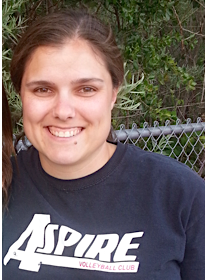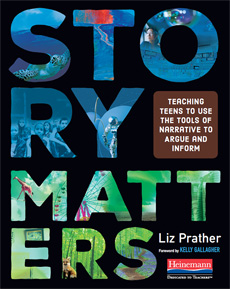Infusing Narrative into Nonfiction Writing
Story Matters: Teaching Teens to Use the Tools of Narrative to Argue and Inform
By Liz Prather
(Heinemann, 2019 – Learn more)

If you’ve ever had the privilege of sitting in a Writing Project training, you know the real power of that presentation is that a classroom teacher is presenting. And I don’t mean someone who used to be in the classroom long ago.
No. You get the real deal with Writing Project professional development sessions. These teachers will tell you what they did in their classroom, what worked, what didn’t, and will show you some student work as evidence of how the lesson went with real kids.

Prather teaches at and is a teacher consultant with the Kentucky Writing Project, which falls under the umbrella of the National Writing Project. Reading her book feels like you’re sitting in a Saturday training with her, learning how to get kids writing.
Beyond narrative, argumentative, and informational silos
One of the things that I learned during my summer institute with the Writing Project is that we are often caught trying to place our writing assignments into one of three “writing types – narrative, argumentative, and informational.
The Writing Project seeks to show teachers how to get kids writing across the text types, since real life writing often requires us to do just that. Story Matters gives teachers concrete ways to “get real” – to get kids writing, reading like writers, and writing some more! It is a book that any teacher of middle or high school English should get their hands on.
A lot of great stuff is packed into these seven chapters: ideas on top of ideas for mentor texts, lesson ideas to teach certain writing skills or techniques, and many student examples from Prather’s classes. I’m in awe at just how many articles she reads and her ability to think about how she can use what she reads to teach students to be stronger writers.
Mentor texts are really the shining star of this book, and Prather does not disappoint, giving readers of her book copious amounts of extra reading to bring into their own classrooms. And do not fear if you read this book and think to yourself, these books and articles she mentions are a bit above the reading level of my kids. I thought that too. Prather mentions at various points of the book to use what will work best for your students, and gives pointers on how to pick articles to use as mentor texts in your particular classroom, middle or high.
Narrative is everywhere
Chapter one explains her philosophy: narrative is everywhere. Narrative, Prather argues, is essential for strong arguments and to inform others about the world. Narrative is how we relate to each other.
To make her point, Prather uses a mentor text and guides her readers as she might one of her own classes. She goes paragraph by paragraph through an article about urban rats, highlighting the particular writing moves that students might want to emulate later when they write their own piece.
The beauty of chapter one was that it gives both novice and experienced teachers a way to explicitly point out what writers do so that students are not left wondering how a writer crafted their piece. To highlight this idea, she then shows a piece of student writing that was modeled after the urban rats article.
I was able to take that idea and use it in my classroom the week after I read it! It’s an assignment I need to work on and make better for future classes, but I had confidence enough to try it thanks to Prather’s guidance.
Writing what you care about
“Writing what you know is not as important as writing what you care about” (29). Getting students to want to write well is what the next chapter is about. Prather argues that assigning generic topics and asking students to care enough about the topic and about writing well is, in effect, killing student joy of writing.
Instead, we need to help students find intriguing stories in topics or topics in stories. When they do, they’ll want to engage in the struggle of writing. This chapter has various exercises to teach students to look for things they care about and want to write about..
Chapter three focuses on characters in nonfiction writing. Instead of creating characters, as a writer would do in a fictional piece, now we must find the characters in nonfiction pieces. By using human stories in nonfiction writing, students are able to not only ground the reader in something familiar, but are able to engage their reader right away.
Prather describes multiple ways a writer can find their character, whether human or not, and make their point just as well, if not better, than a writer using no narrative techniques.
Tension. It is what makes stories worth reading, and is something I’ve always struggled to teach my young writers. Prather gives some practical tips in chapter four to help student writing move forward in a way that makes the reader keep coming back for more.
It’s not difficult for students to see how boring writing can be without tension. Prather gives you the tools to help teach students how to build some tension into their pieces.
Freeing students from the five-paragraph essay
Chapter five was extremely useful, especially if you are looking to ditch the five-paragraph essay. This chapter highlights the importance of mentor texts especially well. Prather shows how the three text types can be woven together by pointing out various structure types in a myriad of mentor texts. She also writes about the ways she has students break down a piece and build it back up, looking at structure specifically.
Many of the lessons she mentions in chapter five are practical to the point that you can use them in class the next day if you need to. Each lesson shows where stories can be incorporated into the structure of a nonfiction piece and where students can take a more creative approach to an essay instead of writing a thesis and backing it up with three pieces of textual evidence. Prather argues that we should instead ground our readers in the stories within our topics, and choose a structure that best suits our needs.
Like previous chapters, chapter six does not leave readers wanting. The chapter covers how we include details in our writing. Again using mentor texts to highlight both particular details and purposeful details, Prather explains how she works with students to choose details for their pieces.
Along these same lines, chapter seven looks at language. Both word choice and sentence crafting are examined in this final chapter. And true to form, Prather gives various lesson ideas so that students may practice these skills in their pieces. Both chapters six and seven center on using stories within nonfiction writing, and making sure that students can see how published writers choose details to include and how to craft strong, deliberate sentences.
Sample unit plans and so much more
At the conclusion of the book, Prather gifts readers with sample unit plans. The unit plans are broken up daily, and each day has a mentor text to examine or a writing focus for students to practice. Seeing how a writing teacher of her caliber orients her class is extremely helpful and will be valuable to me when planning future writing assignments.
The final nugget in this book is an eight-page list of potential mentor texts. All are rather recent, given this book was published in 2019, and all were mentioned at some point in the chapters of the book, even if they were not extensively studied.
This book is so valuable. If we are to teach students to be better writers, better communicators, then we need to teach them real world writing. Story Matters is the guide teachers need to do just that. Writing does not need to be torture, and neither does teaching writing!
Michelle Voelker is an 8th grade English and U.S. History teacher at a Title I school in Sacramento, CA. Recently, she was a fellow with Area 3 Writing Project, a subset of the National Writing Project in their Summer Institute and is now a teacher consultant, providing workshops on writing in the history classroom. Before becoming a teacher, Michelle was an AmeriCorps member for a program that provided reading intervention on Title I elementary campuses. Since then, she has worked to make sure that every kid loves to read and can acquire the skills needed to become a lifelong reader.































This was very informative and helpful to start my career as ELAR teacher :-)